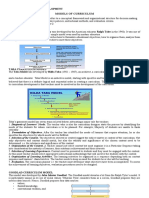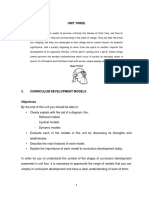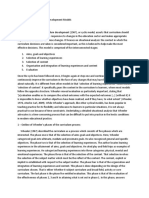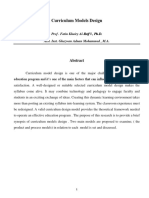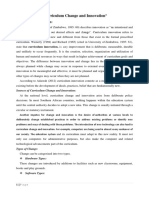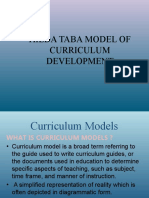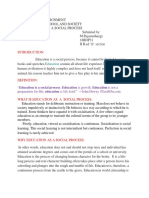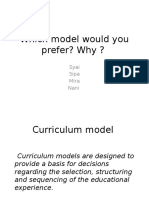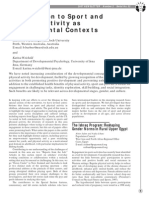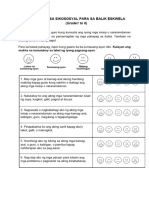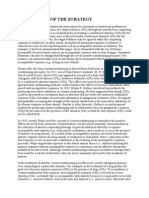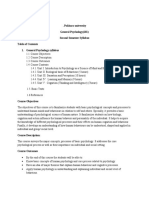Wheeler Model PDF
Wheeler Model PDF
Uploaded by
norliyananingsih iderisCopyright:
Available Formats
Wheeler Model PDF
Wheeler Model PDF
Uploaded by
norliyananingsih iderisOriginal Title
Copyright
Available Formats
Share this document
Did you find this document useful?
Is this content inappropriate?
Copyright:
Available Formats
Wheeler Model PDF
Wheeler Model PDF
Uploaded by
norliyananingsih iderisCopyright:
Available Formats
International Journal of Physical Education, Sports and Health 2015; 1(4): 57-59
P-ISSN: 2394-1685
E-ISSN: 2394-1693
IJPESH 2015; 1(4): 57-59
2015 IJPESH
www.kheljournal.com
Received: 22-02-2015
Accepted: 03-03-2015
Gautam Kumar Chaudhary
Ph.D. Research scholar,
Department of Physical Education
and Sports Sciences, University of
Delhi, India
Rohit Kalia
Ph.D. Research scholar,
Department of Physical Education
and Sports Sciences, University of
Delhi, India
Development curriculum and teaching models of
curriculum design for teaching institutes
Gautam Kumar Chaudhary, Rohit Kalia
Abstract
The present research investigated the curriculum development and teaching models of various teaching
institutes. In this research, researcher found that curriculum designing is conducted stage by stage in
every institute. According to research some of the models discussed the process to be more important
than the objectives. Other models take objectives to be the most important feature of curriculum design.
Generally, all models stress the importance of considering a variety of factors that influence curriculum.
Now that you have read about the types of curriculum design, factors that influence curriculum design
and models used to design the curriculum.
Keywords: Development curriculum, teaching models, curriculum design, teaching institutes
1. Introduction
Curriculum design is a complex but systematic process. This research paper describes a variety
of models of curriculum design in order to make this complex activity understandable and
manageable. It is important for you as a teacher to understand how the curriculum you are
using in your school and college was designed.
Curriculum design, development and assessment are central to teaching and learning in the
classroom. In India, teachers may have either a professional teaching qualification or only an
academic qualification. However, it is important for all teachers to be knowledgeable about the
theory, design and assessment of curriculum. This module provides teachers with information
about the basic elements, factors and institutions involved in the design and assessment of
school & college curricula.
If you are aware of the factors that influence curriculum design, you will be able to understand
how the content you are teaching and the learning experiences to which the children are
exposed have been selected. You may also develop some insight into the methods you can use
to deliver this content. Therefore, this research paper will help you to understand the various
factors that influence curriculum design.
The Concept of Curriculum
As a teacher, you need to know what curriculum means in order to:
Relate education to the socio-economic, technological, political and environmental
demands of your society.
Relate content or the body of knowledge to your local setting.
Apply the most effective and relevant teaching and learning methodologies.
Evaluate teaching and learning processes in your education system.
Correspondence:
Gautam Kumar Chaudhary
Ph.D. Research scholar,
Department of Physical
Education and Sports Sciences,
University of Delhi, India.
Definition of Curriculum
Curriculum is a process, which includes all the academic activities known as syllabi contents
and co-curricular activities and experience to influence the development of the child [1]
In The Curriculum, John Franklin Bobbitt said that curriculum, as an idea, has its roots in the
Latin word for race-course, explaining the curriculum as the course of deeds and experiences
through which children become the adults they should be, for success in adult society.
~57~
International Journal of Physical Education, Sports and Health
Process Model
Objectives
After studying this research paper, you should be able to:
Discuss various models of curriculum design.
Compare curriculum design models.
Explain steps in curriculum design in relation to models of
curriculum.
Content
This unit covers the following models of curriculum design:
The objectives model,
The process model,
Tylers model,
Wheelers model, and
Kerrs model.
The Objectives Model
The objectives model of curriculum design contains content
that is based on specific objectives. These objectives should
specify expected learning outcomes in terms of specific
measurable behaviours.
This model comprises four main steps:
Agreeing on broad aims which are analysed into
objectives,
Constructing a curriculum to achieve these objectives,
Refining the curriculum in practice by testing its capacity
to achieve its objectives, and
Communicating the curriculum to the teachers through the
conceptual framework of the objectives. (Gatawa, 1990:
30)
Objectives Model
Adapted from Gatawa, B. S. M. (1990: 31). The Politics of the School
Curriculum: An Introduction. Harare: Jongwe Press.
It is important to note that in the process model:
Content and methodology are derived from the goals.
Each of them has outcomes that can be evaluated.
The evaluation results from the outcome are fed into the
goals, which will later influence the content and
methodologies. Unlike the objectives model, there is no
direct evaluation of the content and methodologies.
Tylers Model
Tylers model for curriculum designing is based on the
following questions:
What educational purposes should the school seek to
attain?
What educational experiences can be provided that is
likely to attain these purposes?
How can these educational experiences be effectively
organised?
How can we determine whether these purposes are being
attained?
Tylers Model
Adapted from Gatawa, B. S. M. (1990: 28). The Politics of the School
Curriculum: An Introduction. Harare: Jongwe Press.
You will note that in this model:
Evaluation is done at each stage of the curriculum design.
Content, materials and methodology are derived from the
objectives.
The Process Model
Unlike the objectives model, this model does not consider
objectives to be important. Using this model presupposes that:
Content has its own value. Therefore, it should not be
selected on the basis of the achievement of objectives.
Content involves procedures, concepts and criteria that
can be used to appraise the curriculum.
Translating content into objectives may result in
knowledge being distorted.
Learning activities have their own value and can be
measured in terms of their own standard. For this reason,
learning activities can stand on their own. (Gatawa, 1990:
31)
Adapted from Urevbu, A. O. (1985: 20). Curriculum Studies.
The model is linear in nature, starting from objectives and
ending with evaluation. In this model, evaluation is terminal. It
is important to note that:
Objectives form the basis for the selection and
organisation of learning experiences.
Objectives form the basis for assessing the curriculum.
Objectives are derived from the learner, contemporary life
and subject specialist.
To Tyler, evaluation is a process by which one matches the
initial expectation with the outcomes.
~58~
International Journal of Physical Education, Sports and Health
Wheelers Model
Wheelers model for curriculum design is an improvement
upon Tylers model. Instead of a linear model, Wheeler
developed a cyclical model. Evaluation in Wheelers model is
not terminal. Findings from the evaluation are fed back into
the objectives and the goals, which influence other stages.
Wheelers Model
In Kerrs model, objectives are divided into three groups:
Affective
Cognitive
Psychomotor.
The model further indicates that knowledge should be
(Urevbu, 1985):
Organised,
Integrated,
Sequenced, and
Reinforced.
Evaluation in Kerrs model is the collection of information for
use in making decisions about the curriculum.
School learning experiences are influenced by societal
opportunities, the school community, pupil and teacher
relationships, individual differences, teaching methods,
content and the maturity of the learners. These experiences are
evaluated through tests, interviews, assessments and other
reasonable methods.
In his model, Kerr asserts that everything influences
everything else and that it is possible to start an analysis at any
point (Urevbu, 1985: 22).
Adapted from Urevbu, A. O. (1985: 22). Curriculum Studies.
Wheeler contends that:
Aims should be discussed as behaviours referring to the
end product of learning which yields the ultimate goals.
One can think of these ultimate goals as outcomes.
Aims are formulated from the general to the specific in
curriculum planning. This results in the formulation of
objectives at both an enabling and a terminal level.
Content is distinguished from the learning experiences
which determine that content.
Kerrs Model
Most of the features in Kerrs model resemble those in
Wheelers and Tylers models. However, Kerr divided the
domains into four areas (Urevbu, 1985: 23):
Objectives,
Knowledge,
Evaluation, and
School learning experiences.
A simplified version of Kerrs model of curriculum design is
shown below.
2. Summary
The curriculum design models discussed show that curriculum
designing is conducted stage by stage. Some of the models
discussed consider the process to be more important than the
objectives. Other models take objectives to be the most
important feature of curriculum design. Generally, all models
stress the importance of considering a variety of factors that
influence curriculum.
Now that you have read about the types of curriculum design,
factors that influence curriculum design and models used to
design the curriculum.
3. References
1. http://en.wikipedia.org/wiki/Curriculum, 10 Mar, 2015.
2. http://www.tki.org.nz/r/health/curric_devt/lit_review/pe/lit
rev_pe7_e.php, 10 Mar, 2015.
3. Rakesh Gupta, Akhilesh Sharma, Santosh Sharma,
Professional Preparation and Curriculum Design in
Physical Education & Sports sciences, Friends
Publications (India), New Delhi, P. 11
4. Tichafa J, Chikumbu, Curriculum theory, design and
assessment, Ministry of Education, Sport and Culture
Masvingo, Zimbabwe, The Commonwealth of Learning,
2000.
What you should note about the model is that:
The four domains are interrelated directly or indirectly,
and
Objectives are derived from school learning experiences
and knowledge.
~59~
You might also like
- Allens Cognitive Level Screen ACLS and LACLSDocument7 pagesAllens Cognitive Level Screen ACLS and LACLSKaye Tiu100% (2)
- Ralph Tyler Model of Curriculum DevelopmentDocument2 pagesRalph Tyler Model of Curriculum DevelopmentTamkeen sherani100% (6)
- Wheeler Curriculum ModelDocument3 pagesWheeler Curriculum ModelJan Jan Phang96% (28)
- Tyler's Curriculum ModelDocument14 pagesTyler's Curriculum ModelSimple Lad100% (1)
- Disadvantages of Tyler Model and How To ImplementDocument7 pagesDisadvantages of Tyler Model and How To ImplementAghilah Chandrasekaran50% (2)
- Models of CurriculumDocument5 pagesModels of CurriculumMarianne Parohinog75% (4)
- Curriculum Models Taba ModelDocument7 pagesCurriculum Models Taba ModelQurban AliNo ratings yet
- Hilda Taba Model of Curriculum DevelopmentDocument6 pagesHilda Taba Model of Curriculum DevelopmentKarthik Karthi100% (10)
- Tyler S Model of Curriculum DevelopmentDocument21 pagesTyler S Model of Curriculum Developmenttrawr92% (13)
- Ralph Tyler - CurriculumDocument11 pagesRalph Tyler - CurriculumMClarissaE86% (22)
- Curriculum Approaches and FoundationDocument9 pagesCurriculum Approaches and FoundationRodrick Sonajo Ramos100% (3)
- Stenhouse ModelDocument12 pagesStenhouse Modelmizizh100% (1)
- Stenhouse's ModelDocument9 pagesStenhouse's ModelSiehah Nasihah78% (9)
- Designs of Curriculum OrganizationDocument32 pagesDesigns of Curriculum OrganizationRao Jahnzaib91% (11)
- MG101 Exam F2FDocument9 pagesMG101 Exam F2FTetzNo ratings yet
- Decision Making, Personhood and Dementia - Examining The Interface PDFDocument226 pagesDecision Making, Personhood and Dementia - Examining The Interface PDFBruna BrönstrupNo ratings yet
- Models of CurriculumDocument13 pagesModels of CurriculumMallika JoonNo ratings yet
- WheelerDocument2 pagesWheelerJojo Circus100% (2)
- Curriculum Models.Document27 pagesCurriculum Models.given kalukangu100% (4)
- Curriculum Components and ApproachesDocument6 pagesCurriculum Components and ApproachesRico BasilioNo ratings yet
- Curriculum Model: Is Defined As A Plan of Action That Can Be Employed From A Theory Into PracticeDocument21 pagesCurriculum Model: Is Defined As A Plan of Action That Can Be Employed From A Theory Into PracticeKritika Ramchurn100% (1)
- Wheeler's ModelDocument2 pagesWheeler's Modelyoungpohping84% (25)
- 7-Curriculum Models Theories in EducationDocument17 pages7-Curriculum Models Theories in EducationSaiqa Siddiqui100% (1)
- Types of Curriculum DesignsDocument3 pagesTypes of Curriculum DesignsJenica Cruz71% (7)
- Curriculum Design ModelsDocument28 pagesCurriculum Design ModelsMichael Peralta Mahinay100% (1)
- Hunkins ModelDocument2 pagesHunkins Modelstephen misoi100% (1)
- Curriculum Organization and DesignDocument5 pagesCurriculum Organization and DesignDonna Rillorta100% (1)
- IdealismDocument6 pagesIdealismdiazjanice.f100% (1)
- Curriculum ModelsDocument12 pagesCurriculum ModelsRhubhambikhei Murugan83% (6)
- Components of Curriculum DevelopmentDocument2 pagesComponents of Curriculum Developmentaluja100% (1)
- Taba ModelDocument29 pagesTaba ModelSALLY LEW100% (4)
- 1-Types of CurriculumDocument2 pages1-Types of CurriculumKhalid Mahmood80% (5)
- Hilda TabaDocument5 pagesHilda TabaÅyẻŞhã Jãbẻẻn100% (1)
- Huma Khan 8603Document61 pagesHuma Khan 8603Ayesha Tayyab0% (1)
- Curriculum NotesDocument28 pagesCurriculum NotesSwami Gurunand20% (5)
- Curriculum Change and InnovationDocument9 pagesCurriculum Change and InnovationbabyNo ratings yet
- Systems Approach To Curricular Development: Lea Garcia SambileDocument26 pagesSystems Approach To Curricular Development: Lea Garcia SambileLea Sambile100% (1)
- CurriculumDocument72 pagesCurriculummgar10100% (4)
- Core CurriculumDocument7 pagesCore CurriculumKashif Farid100% (1)
- Compare and Contrast Tylers To Wheer's Curriculum ModelDocument4 pagesCompare and Contrast Tylers To Wheer's Curriculum ModelKabz 18786% (7)
- Teacher Centered Curriculum, The Role of Teachers & CurriculumDocument7 pagesTeacher Centered Curriculum, The Role of Teachers & CurriculumLawan YusufNo ratings yet
- 8603-1 SanaDocument28 pages8603-1 SanaAreeba M.jNo ratings yet
- Core Curriculum: Presented By: Group 3Document32 pagesCore Curriculum: Presented By: Group 3alisha1saleem-1No ratings yet
- Hilda Taba Model of Curriculum Development: Presentation TopicDocument17 pagesHilda Taba Model of Curriculum Development: Presentation TopicpreyangkaNo ratings yet
- Aims, Goals, ObjectivesDocument19 pagesAims, Goals, ObjectivesAli imtiazNo ratings yet
- Taba Model of Curriculum Development - Educare We Educate, WeDocument4 pagesTaba Model of Curriculum Development - Educare We Educate, WeUma SinghNo ratings yet
- Ralph Tyler ModelDocument26 pagesRalph Tyler ModelMichael John Canlas100% (2)
- Variables of Teaching - Aileena MerajDocument22 pagesVariables of Teaching - Aileena MerajAileenaMerajNo ratings yet
- Determinants of Curriculum Development-Sem-4, B.ed-By Satya JhaDocument18 pagesDeterminants of Curriculum Development-Sem-4, B.ed-By Satya JhaDipti kumariNo ratings yet
- Decker Walker'S Naturalistic MODEL (1971)Document7 pagesDecker Walker'S Naturalistic MODEL (1971)Seaweed Szee Huei0% (1)
- Curriculum Development Process in PakistanDocument8 pagesCurriculum Development Process in PakistanMuhammad Usama100% (1)
- Privatization of Education - 1Document16 pagesPrivatization of Education - 1Jee MusaNo ratings yet
- Education As A Social ProcessDocument5 pagesEducation As A Social Processmrm MNo ratings yet
- Curriculum Design and Instruction EDUC2118Document19 pagesCurriculum Design and Instruction EDUC2118Ishfaq100% (2)
- Hilda Taba ModelDocument14 pagesHilda Taba Modelkhairul80% (5)
- Bacani-De Jesus - Concept and Scope of Comparative EducationDocument31 pagesBacani-De Jesus - Concept and Scope of Comparative EducationJewels GarciaNo ratings yet
- Wheeler's ModelDocument15 pagesWheeler's Modelyoungpohping86% (7)
- Types of CurriculumDocument8 pagesTypes of CurriculumZiaUrRehman67% (3)
- Differences Between Tyler's and Wheeler's ModelDocument2 pagesDifferences Between Tyler's and Wheeler's ModelDamilola Adamolekun100% (6)
- Types of Curriculum DesignDocument2 pagesTypes of Curriculum DesignM Salman Awan100% (1)
- Handbook of Research on TeachingFrom EverandHandbook of Research on TeachingCourtney BellNo ratings yet
- 03 Models of CurrculumDocument30 pages03 Models of CurrculumHazel GraceNo ratings yet
- SAQ5Document16 pagesSAQ5Jazmin Nicole PecundoNo ratings yet
- Narcisism vs. Stima de Sine DaDocument5 pagesNarcisism vs. Stima de Sine DaStelii StNo ratings yet
- Introduction To Sport and Physical Activity As Developmental ContextsDocument42 pagesIntroduction To Sport and Physical Activity As Developmental ContextsAisyahMKNo ratings yet
- Psy 1205 Lesson 1 - IntroductionDocument7 pagesPsy 1205 Lesson 1 - IntroductionJoseph KhaembaNo ratings yet
- STS Agora Movie ReviewDocument2 pagesSTS Agora Movie ReviewheheNo ratings yet
- Career Path WorksheetDocument4 pagesCareer Path Worksheetarelyta8123No ratings yet
- Lazy Way To HappinessDocument32 pagesLazy Way To HappinessHSum201367% (3)
- Silent BallDocument2 pagesSilent Ballapi-269095451No ratings yet
- Tool & Guide Sa Pagsusuri Sa Sikososyal Grade 1-6Document5 pagesTool & Guide Sa Pagsusuri Sa Sikososyal Grade 1-6Jessa NacurayNo ratings yet
- OcdDocument9 pagesOcdapi-334485329No ratings yet
- Mini SurveyDocument21 pagesMini SurveyAdlanRamlyNo ratings yet
- Counter ConditioningDocument5 pagesCounter Conditioningiulia9gavrisNo ratings yet
- J. Boucher: The Autistic Spectrum: Characteristics, Causes, and Practical IssuesDocument5 pagesJ. Boucher: The Autistic Spectrum: Characteristics, Causes, and Practical IssuesCristian HanganNo ratings yet
- Milgram - 1998 - Personality and Individual Differences PDFDocument20 pagesMilgram - 1998 - Personality and Individual Differences PDFMartin RuízNo ratings yet
- Pokhara University General Psychology (Me)Document34 pagesPokhara University General Psychology (Me)krishnaNo ratings yet
- Lesson Plan ComsumerismDocument6 pagesLesson Plan ComsumerismAnonymous 0gPiyssVNo ratings yet
- Balakrishnan 2021Document14 pagesBalakrishnan 2021rizky amaliaNo ratings yet
- The Nature of Science Drama in Science Education PDFDocument5 pagesThe Nature of Science Drama in Science Education PDFAlia FahmyNo ratings yet
- Nov 2020 Science Club NewsletterDocument6 pagesNov 2020 Science Club Newsletterapi-529182210No ratings yet
- Scrumchkin InstructionsDocument2 pagesScrumchkin Instructionssuper_sumoNo ratings yet
- The Art of Small TalkDocument26 pagesThe Art of Small TalkKing George100% (6)
- My FS2Document45 pagesMy FS2joel blaya0% (1)
- Cognition and AddictionDocument413 pagesCognition and AddictionAndrei Beteringhe89% (9)
- Competitive Anxiety and Superstitious Rituals Among Athletes at A Private UniversityDocument8 pagesCompetitive Anxiety and Superstitious Rituals Among Athletes at A Private Universityivy singsonNo ratings yet
- Banana TimeDocument3 pagesBanana TimejohncarmiNo ratings yet
- CHAPTER 8: Selecting A Study DesignDocument2 pagesCHAPTER 8: Selecting A Study Designalia.delareine100% (1)
- CS 108 - Human Computer InteractionDocument17 pagesCS 108 - Human Computer InteractionWILSON LLAVENo ratings yet
- The Effects of Pre-Reading Activities On ESP Reading ComprehensionDocument9 pagesThe Effects of Pre-Reading Activities On ESP Reading ComprehensionRindha Dwi Maila PutriNo ratings yet





